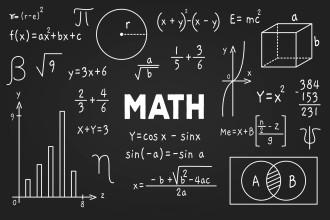A strong instrument that supports our comprehension of the world, mathematics is frequently referred to as the universal language. It can be broadly divided into four categories, each having special qualities and uses. You must have heard from your friends about the Maths Homework Help, isn’t it? But why students have been using this term for Mathematics subject?
For a variety of reasons, mathematics has emerged as one of the most significant academic subjects. Its importance extends well beyond figures and computations. Learning mathematics gives people a methodical way to solve problems. Students can apply mathematical concepts to real-world settings through its foundation in areas like computer science, engineering, and physics.
Mathematics and STEM Education: Fostering Innovation
STEM (Science, Technology, Engineering, and Mathematics) is an abbreviation that stands for innovation and advancement in the ever-changing field of education. The foundation of STEM is mathematics, a topic that is not only found in textbooks but also acts as a dynamic engine for advancement and creativity in the actual world.
-
Creativity in Mathematics:
Creativity is the lifeblood of innovation, which is not a strict process. Many people view mathematics as a discipline that just involves rules and formulas, but in reality, there is a lot of room for creativity. It pushes pupils to investigate, try things out, and come up with fresh approaches to arithmetic issues.
-
Getting Future Innovators Ready:
The future generation of innovators can be prepared through STEM education, which has mathematics at its foundation. By fostering a thorough comprehension of mathematics and its applications, we give pupils the fundamental abilities they need to push the envelope of what is conceivable.
In summary, mathematics and STEM education are not merely academic disciplines; rather, they are the engines of creativity that advance humankind.
Four Branches of Mathematics
-
Symbolic Language: Algebra
We can explain relationships and solve complicated issues with algebra, which gives numbers a novel twist by substituting symbols. Equation solving, variable manipulation, and unknown discovery are the key components. Modelling real-world situations and identifying underlying patterns in data are made easier by algebra, which is a useful tool in many disciplines, including physics, engineering, and economics. Algebra unlocks the ability to solve a wide range of issues, from figuring out a rocket's trajectory to optimizing business strategy.
-
Geometry
Imagine a world without geometry, one in which engineers construct bridges without regard for angles, architects build crooked structures, and artists find it difficult to compose harmoniously. It is challenging to comprehend, as geometry is the unsung hero responsible for the symmetrical marvels of our universe, the silent composer of the lines, angles, and forms that give our world its structure. Lines and angles, which are the fundamental building blocks of geometry, are its language. It is the language by which the underlying structure of the world is understood.
-
Number Poetry in Arithmetic
Within the enormous field of mathematics, there is a small but significant art form called arithmetic. The most basic mathematical operations are woven into the fabric of our existence, much like the metermatic verses of a poem. Arithmetic is the foundation of our numerical existence, from the point at which we start to count to the intricacies of financial planning and scientific computations. The foundation of the entire mathematical universe is arithmetic, which is frequently seen as basic. Its simplicity and universality, which empower us in our day-to-day lives and act as a springboard for more challenging mathematical explorations, are what give it beauty. Its song helps us dance through the complexities of our daily jobs, and its rhythm maintains the harmony of our numerical universe.
-
Calculus
Calculus is like an artist's brushstroke on a canvas of change and motion; it is a brilliant masterwork in the field of mathematics. It's a symphony of mathematics that harmonizes our understanding of how things change and leads to a world of complex problem solutions. Similar to yin and yang, differential calculus and integral calculus are the twin pillars that support our understanding of the dynamic characteristics of the universe. Say you want to know how your speed fluctuates on twisting roadways and steep slopes as you're travelling. Differential calculus now takes the stage. You may compute instantaneous slopes at every point along your travel because it is the conductor of rates of change. You can use differential calculus to determine the exact instant when you stop or climb a difficult hill and the speedometer needle moves.
Number theory, linear algebra, statistics, and other topics are only a few of the numerous branches of mathematics that can be further subdivided into. These are just four of the many disciplines of mathematics. A vast array of academic fields and commercial sectors use mathematics, making it a flexible and varied field.
Why Do Students Find Mathematics A Complex Subject?
Because of its abstract character, complicated concept relationships, and reliance on exact logic, mathematics is frequently seen as a challenging topic. The following are several explanations for why mathematics is thought to be complex, along with examples to show these explanations:
- Accuracy: Precision and rigorous respect for rules are required in mathematics. Incorrect outcomes can arise from even the smallest mistake in a mathematical calculation or proof. In geometry, a proof's entire argument may collapse if you alter merely one angle measurement. It makes students search for Do My Maths Homework for university projects.
- Structure in Hierarchies: In mathematics, ideas are hierarchically layered onto one another. To tackle increasingly complex subjects, one must have a firm grasp of foundational ideas. Calculus, for example, expands upon algebra and trigonometry. Calculus can be intimidating if you don't have a solid foundation in these subjects.
- Numerous Paths to Solutions: Math sometimes provides you with more than one method to tackle an issue. Despite their seeming complexity, these several approaches finally result in the same answer. For instance, a differential equation can be solved using a variety of methods, including variable separation, substitution, and factor integration.
- Frontiers Changing: Mathematical concepts are dynamic. Its horizons are always being broadened by new findings and theories. Things like chaos theory and fractals, which were once thought to be complicated, are now basic ideas in modern mathematics.
In conclusion, the abstract character, hierarchical structure, accuracy, adaptability, and demand for sophisticated logic and reasoning are the main causes of mathematics' complexity. Despite its sometimes difficult nature, mathematics' complexity is precisely what makes it useful for modelling, describing, and solving a wide range of issues and occurrences in the scientific and social sciences.
Conclusion
"Mathematics and STEM Education" serves as the foundation for future innovation and advancement. Science, Technology, Engineering, and Mathematics (STEM) and mathematics have a complex link that is a dynamic force that opens up a world of seemingly endless possibilities for us. This collaboration is about developing curious minds, encouraging problem-solvers, and raising the next wave of innovators—it's not just about math and figures. The goal of this partnership is to provide students with the skills necessary to take on challenging assignments and adapt to a world that is continuously changing. In STEM education, mathematics serves as a compass to assist students in navigating the complex terrain of science, technology, engineering, and mathematics, much as online assignment help that is intended to provide an organized and customized approach to academic success.







